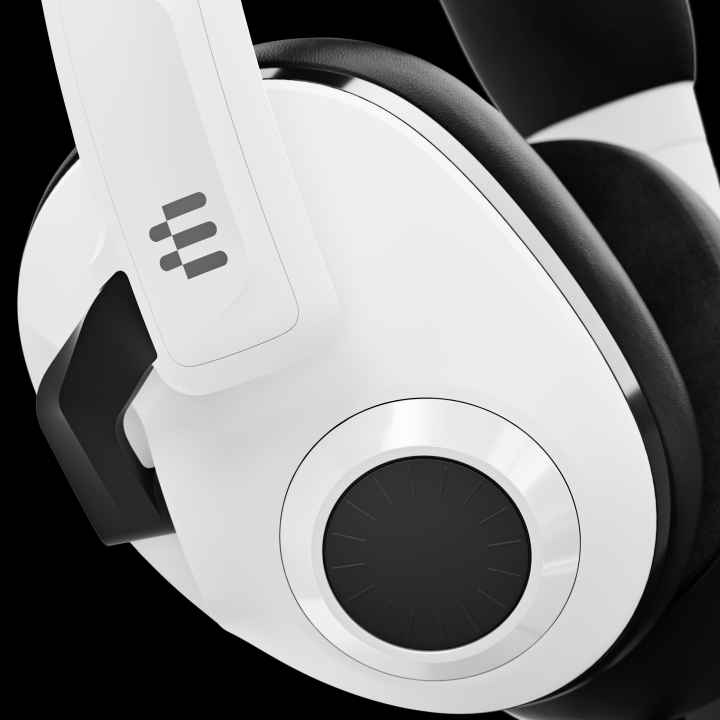EPOS H3 Gaming Headset PS5 & PS4 Review – It is tough to believe that it has been almost a year since I posted my review for the Sennheiser GSP 300 Gaming Headset. Eleven long months, and I am still sitting in front of the same computer, still using the same headset for work. I’m still just as in love with the GSP 300 as I was on the day I wrote that review. The sound quality, the sturdy build, the amazing mic quality; all of these have held up incredibly well over a year of ridiculously high use during our global stay-at-home party.
But companies are going to be companies, whether the world is hanging out in its boring old flat all year or not. Sennheiser has been in the midst of a corporate restructuring, and now it’s gaming (and air traffic control, which is kind of like very high stakes gaming) headsets are being produced under the EPOS brand. EPOS has now fully announced the successor to my beloved GSP 300 and I was fortunate enough to have early access, putting the headset through its paces.
EPOS H3 Gaming Headset Review
The EPOS H3 Is A True Evolution
So, if you are anything like me, I know you are wondering – did EPOS change anything about the headset beyond the label, or is this the same GSP 300 in a fancy new box? Rest assured that yes, this is indeed an “evolution” of the GSP 300. So much so, in fact, that if I didn’t read the press release and do a little research, I would think that this was a completely new and separate product. Comparing the two products side by side, almost nothing is the same.
The engineers behind the EPOS H3 left no stone unturned while rethinking their mid-priced corded headset. One interesting decision must have led to another, then another, until the entire product was altered beyond recognition – in a good way, of course. This is one gorgeous headset.
The EPOS H3 comes in two variations – Onyx Black and Ghost White. PlayStation 5 owners will want to jam on the “Buy” button for the Ghost White variation, because the black and white color configuration beautifully compliments the DualSense controller, looking like a licensed Sony product. Was this on purpose? You can probably bet your last Dogecoin that it was.
Noticeable Build Improvements
There are so many improvements to this already stellar headset that I don’t know where to begin. Let’s start with the cord, which can serve as a metaphor for the thinking behind this redesign. Last year’s GSP 300 has a standard rubber coated cord, which split in two for use with a PC (one jack for the mic, another for the earphones). An adapter was supplied for plugging the headset into a single jack, which is primarily how I’ve used it.
The EPOS H3, on the other hand, comes with two very nice weave-covered cables – one for PC use, and one for consoles. The cables actually attach to the underside of the left ear cone, snapping snuggly into place so well that I was a little hesitant to pull them back out.
This prevents the need for a floppy adaptor while playing on consoles. Better still, the console jack is now angled, which helps tremendously when plugging it into a Sony controller. There is no need to baby the cable for fear of gradual connection degradation, because the cable does not awkwardly stick out of the bottom of the controller.
Every aspect of the H3 shows this same thoughtful design. The headband has a dent/curve in it, which prevents it from pulling at your hair or putting too much pressure on your head. The memory foam earpieces now use the same suede material as EPOS’ more expensive headsets – and you can remove and replace them if they get old or damaged. The volume knob has been converted to a dial, inlaid into the side of the right headphone, preventing players from accidentally turning down the sound in the middle of an intense play session (trust me, it happens).
Perhaps my favorite new feature is the stainless steel slider extension bar, which attaches the earphones to the headband. Not only does it lend the headset a sense of sturdiness compared to the previous plastic, but there are engraved, numbered markings to allow OCD-stricken gamers like myself to ensure that both sides are extended evenly from the top.
Before this innovation, I would literally take the headset off and study it to make sure it was even (right before rearranging all the silverware and checking the oven to make sure it is turned off). The band clicks nicely into place with each digit, allowing for precise setup – which is exactly what I need.
Bass! How Low Can You Go?
Clearly, the EPOS H3 is a visually beautiful headset with a lot of smart design choices that make it comfortable to wear. But the most interesting piece of the puzzle to me is how the newly evolved headset sounds.
Does the H3 deliver that wonderful resonant sound that I came to adore from the GSP 300? Is the sound quality just as high as the rest of Sennheiser/EPOS’ products?
Well, that depends on what you are looking for from a headset. I grew up in the era of boomboxes and trunk speakers, where personal worth as a human was judged by how much bass could be produced at a moments notice. So of course, the first thing I do when I get a new headset is plug it into a turntable and crank up Beastie Boys’ Hello Brooklyn to see if it can handle the bass of an endlessly repeating 808.
The EPOS H3 could play the song just fine without distorting, but I immediately noticed that the bass response was somewhat anemic compared to what I am accustomed to. I switched between several headsets on the fly, and the EPOS H3 was definitely the least tooth-rattling in the bunch. But – and this is a big “but” – the headset also revealed details in the track that I had never noticed before.
I did a bit of research, and it turns out that the EPOS H3 is specially tuned to be detail-oriented in a gaming situation. If you are looking to blow your eardrums out with 80’s hip hop, this is not the headset for you. The EPOS H3 is trying to do something more delicate.
As the H3’s press materials put it, the H3 “delivers excellent low-frequency performance for that feeling of immediacy in the bass – but without compromising or masking a tight and accurate midrange that is essential for hearing every nuanced audio cue. Its crystal-clear high frequencies assist positional audio perception when connected to an analogue sound source that delivers surround sound using binaural techniques – such as the Xbox Windows Sonic system or Sony 3D Tempest Engine for the PS5 and Xbox Series X|S consoles.”
In other words, this headset is not going to drown out all of the fine details that go into game audio design with a bunch of thumping bass. This headset is specifically created to allow serious players to hear audio cues in games and react accordingly. The emphasis here is crystalline clarity, not overwhelming power.
The EPOS H3 Performs Admirably
Accordingly, I abandoned my usually gamut of Mystikal and Ludacris tracks, and tested out the EPOS H3 in a number of gaming scenarios. I wore the headset while completing several hunts in Monster Hunter Rise on the Nintendo Switch. I slapped the headset over my ears while playing the new arcade shooter SWARM on the Oculus Quest 2. And of course, I played hours of PlayStation 5, selecting the Final Fantasy XIV beta (to test the microphone), Control (to test the surround), and the Resident Evil Village demo (to test the sound blocking and make-me-scream capabilities).
In all of these scenarios, the EPOS H3 performed admirably. My constantly screaming children were completely blocked out to the point where I occasionally had to slip one of my ears out of the headset to ensure they were still alive.
I was fully absorbed in my ongoing battles with the Rathalos in Monster Hunter Rise. The headset remained snugly on my head no matter how much I lurched around while playing in VR. As expected, the microphone was crystal clear (as reported by my son) in my Final Fantasy sessions.
But the experience that really convinced me of the H3’s selling points was the Resident Evil Village demo. Sound is so much of the experience with horror games, but I was shocked how much of a difference the quality of the H3 made. Every footstep, every tiny atmospheric ticking sound is conveyed with absolute clarity. I found myself holding my breath and listening for movement, and the effect was absolutely immersive.
No matter what I say about the precision of the EPOS H3’s sound, if you are a bass junkie, you are going to want to cross this one off the list and look elsewhere for your next headset. But if you are the sort of player that seeks clarity over volume, you can’t go wrong with this very thoughtfully designed headset. It will reveal details you never realized you were missing.
Is The EPOS H3 Headset For You?
The EPOS H3 is solidly constructed, while still being light enough to be endlessly comfortable. This is the sort of headset that you can wear for hours on end with no strain, absolutely forgetting it is there. The EPOS H3 is slick and it matches Sony’s futuristic products so well that most people will think it came in the box with the PlayStation 5 and its accessories. You could do far worse for $119, but I’m not convinced you could do much better.
Review product provided by the manufacturer for review purposes.






